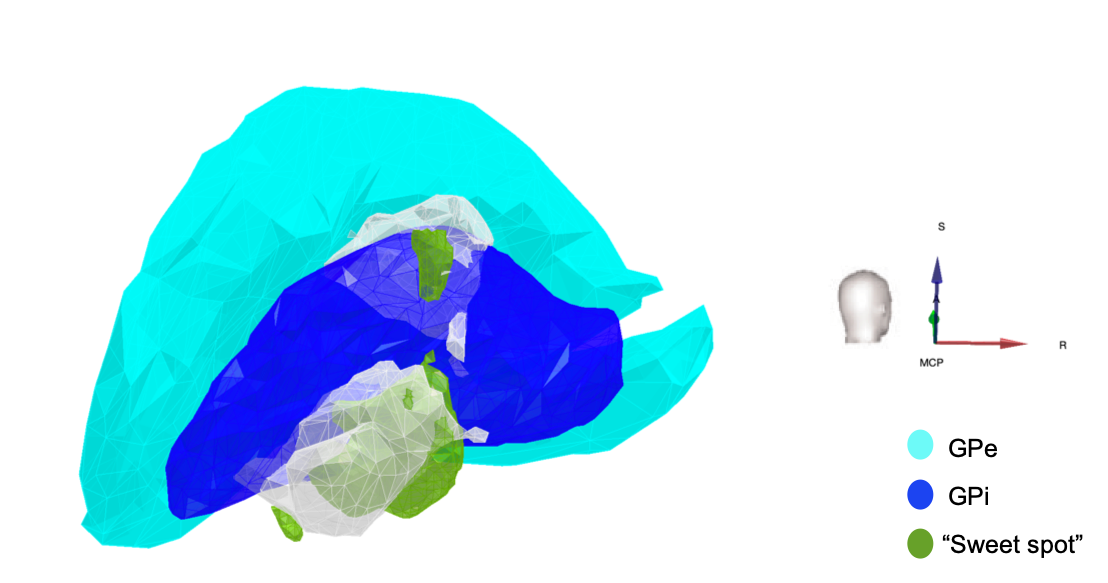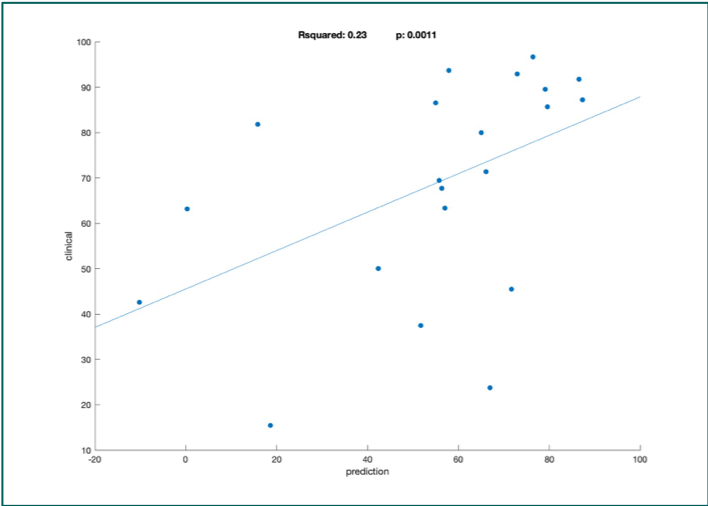Objective: Assess validity and feasibility of a probabilistic response mapping for isolated and combined dystonia.
Background: Probabilistic response mapping is a promising tool to estimate the expected benefit of pallidal deep brain stimulation (DBS-GPi) in patients with dystonia.
Method: Registration of atlas, detection of leads and rendering of volume of tissue activated (VTA) were performed using SureTune software for each patient with generalized and cervical isolated or combined dystonia that underwent bilateral DBS-GPi in our hospital between 2005-2015. Each patient-specific VTA was associated with clinical improvement and the volume with highest likelihood of good outcome was computed. Afterwards, each individual VTA was applied on the previously published probabilistic map by Reich et al. [1]; the correlation between predicted and real clinical benefit based on VTA-atlas model was analyzed in a linear regression model.
Results: We enrolled 32 patients with a mean follow-up of 3 years (10 of which with combined dystonia). The proportion of non-responders was 9.4% and 24% patients had an excellent response (more than 80% of motor benefit) at 3-years follow-up. Subjects with cervical dystonia had a superior clinical benefit, but these results were not statistically significant (78% vs 62%, p=0.098). The volume with highest probability of good outcome was located within the ventroposterior GPi and adjacent subpallidal white matter (Figure 1). A correlation between real clinical improvement and the VTA-atlas model estimation was found (Figure 2). Considering clinical and demographic variables, we are able to explain 32% of the observed variance in DBS response according to this model (r2 = 0.32; P = 0.042).
Conclusion: There is a correlation between observed and predicted clinical improvement based on VTA-atlas model, even in a “real world” cohort with 31% patients diagnosed with combined dystonia. These results emphasize the clinical potential of probabilistic outcome brain mapping in refining the optimal therapeutic volume for pallidal neurostimulation.
This abstract was also submitted for presentation at the 2020 European Academy of Neurology conference.
References: [1] Reich MM, Horn A, Lange F, Roothans J, Paschen S, Runge J, Wodarg F, Pozzi NG, Witt K, Nickl RC, Soussand L, Ewert S, Maltese V, Wittstock M, Schneider GH, Coenen V, Mahlknecht P, Poewe W, Eisner W, Helmers AK, Matthies C, Sturm V, Isaias IU, Krauss JK, Kühn AA, Deuschl G, Volkmann J. Probabilistic mapping of the antidystonic effect of pallidal neurostimulation: a multicentre imaging study. Brain 2019;142(5):1386–1398.
To cite this abstract in AMA style:
C. Soares, M. Reich, F. Costa, J. Roothans, R. Vaz, M.J Rosas, J. Volkmann. Probabilistic response mapping in a cohort of mixed dystonia patients with bilateral pallidal DBS [abstract]. Mov Disord. 2020; 35 (suppl 1). https://www.mdsabstracts.org/abstract/probabilistic-response-mapping-in-a-cohort-of-mixed-dystonia-patients-with-bilateral-pallidal-dbs/. Accessed December 13, 2025.« Back to MDS Virtual Congress 2020
MDS Abstracts - https://www.mdsabstracts.org/abstract/probabilistic-response-mapping-in-a-cohort-of-mixed-dystonia-patients-with-bilateral-pallidal-dbs/


